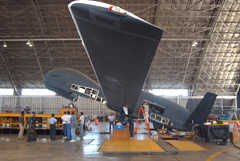
| Global Hawk Passes
Fuel Test at 20 Degrees |
|
|
10/16/2007 - EDWARDS AIR FORCE BASE, CA. -- The 452nd Flight Test Squadron pushed the RQ-4 Global Hawk Block 20 to its fuel system limits during a weeklong starvation test here from Oct. 1 to 4. The testing involved tilting the aircraft to a 20-degree attitude while running the aircraft out of fuel inside the weight and balance hanger. "The testing is very important," said Lt. Col. Andy Thurling, 452nd Flight Test Squadron commander. "It allows us to know the aircraft's fuel requirements in case of a missed landing. This will allow for longer flights and more efficiency in the air." The Block 20 carries 1,000 pounds more payload and 6,000 pounds more fuel than the Block 10, said Capt. Stephen Leggiero, 773rd Test Squadron project engineer. Because of the increase in weight, additional fuel is required for the aircraft. This means an entirely new fuel cell configuration and fuel management system was necessary. Aside from the starvation testing, the team performed a weight and balance test on the aircraft to determine how changes in fuel weight change the aircrafts center of gravity. During the test, the Global Hawk was weighed then placed on blocks to allow additional ground clearance for the tail of the aircraft. After preparation, the team fired up the engines and began to tilt the aircraft. "We tilted the aircraft at the high 20-degree angle to simulate a go-around situation," said 2nd Lt. Garrison Lindholm, 773rd Test Squadron subsystem engineer. A go-around is where the aircraft misses an approach and is
required to climb at a "We wanted to ensure that at the steep deck angle, the pumps would not create an engine flame out resulting in engine failure," Lieutenant Lindholm said. The main parameter for testing was weight, he said. The testers initially weighed the aircraft to determine its gross weight. The team then weighed the aircraft again as it began to show signs of starvation, Captain Leggiero said. This was to measure the amount of fuel in the tank when fuel starvation began. During the testing, the team used a synthetic fuel called Isopar-M instead of standard JP-8 fuel for safety purposes. The JP-8 has a lower flash point, which is the point where fuel ignites. "Overall, the testing went very smoothly," Captain Leggiero said. "It really highlights some of the fantastic infrastructure we have on base, and the wonderful people who pulled together to make things happen." Source: USAF Edwards AFB Press Release by Airman 1st Class Mike Young |
| |
